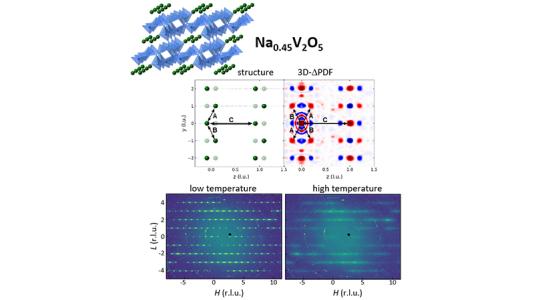
Scientific Achievement
Novel diffuse scattering techniques reveal the presence of short-range ionic order upon intercalation in an archetypical cathode material.
Significance and Impact
Understanding of how order-disorder transitions limit ionic transport is paramount in designing materials with improved properties.
Research Details
- Single crystal diffuse scattering measurements were performed on the cathode material, Na0.45V2O5.
- Measurements over large volumes of reciprocal space enabled transformation into pair distribution functions that reveal short-range order in real space (3D-ΔPDF).
- The 3D-ΔPDF directly shows the formation of ordered zig-zag chains of Na-ions within the vanadium oxide matrix.
- Such atomic ordering of intercalant ions disrupts ionic mobility and hence is detrimental to battery performance.
Argonne National Laboratory seeks solutions to pressing national problems in science and technology. The nation’s first national laboratory, Argonne conducts leading-edge basic and applied scientific research in virtually every scientific discipline. Argonne researchers work closely with researchers from hundreds of companies, universities, and federal, state and municipal agencies to help them solve their specific problems, advance America’s scientific leadership and prepare the nation for a better future. With employees from more than 60 nations, Argonne is managed by UChicago Argonne, LLC for the U.S. Department of Energy’s Office of Science.
The U.S. Department of Energy’s Office of Science is the single largest supporter of basic research in the physical sciences in the United States and is working to address some of the most pressing challenges of our time. For more information, visit https://energy.gov/science.